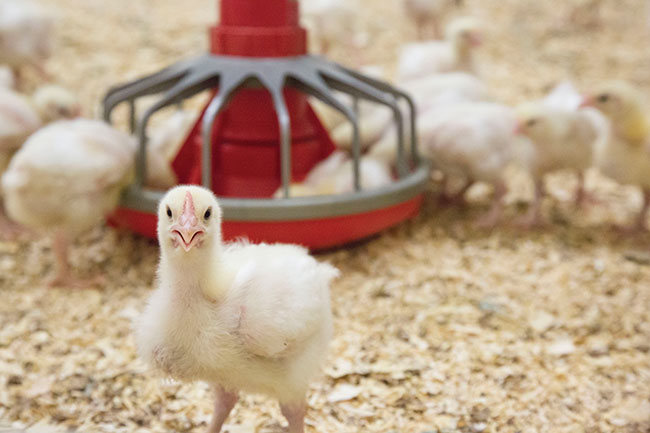
Antibiotics in broilers
By Treena Hein
Features BroilersObservations and outlook on the postponement of the Category III deadline, from various industry stakeholders.
 Chicken Farmers of Canada has postponed the ban on preventative use of Category III MIAs due to the pandemic. PHOTO CREDIT: Alltech Canada
Chicken Farmers of Canada has postponed the ban on preventative use of Category III MIAs due to the pandemic. PHOTO CREDIT: Alltech Canada As Canadian broiler producers well know, their sector has eliminated the use of Category I and II human medically important antibiotics (MIA) for health and growth promotion and disease prevention. While the ban of preventative use of Category III MIAs was set for the end of 2020 – there’s actually just one of them at present, Bacitracin – Chicken Farmers of Canada (CFC) decided in September to reassess the timeframe.
“The realities of the COVID-19 pandemic have resulted in the postponement of key meetings between important partners at a provincial level,” CFC states. “The success of the strategy has been based on taking a responsible approach to ensure animal welfare and sustainability, and these currently remain unresolved…It is important to note that this remains a key priority for the Canadian chicken sector. The reassessment requires further consultation with industry.”
Steve Leech, CFC director of food safety and animal health, notes that there were a number of issues that needed to be examined further, including vaccines, alternative products and industry readiness. “We are continuing with a reassessment of the timeframe and deciding right now on next steps, within CFC and across the stakeholder chain,” he says. “Having the entire industry involved in decisions, the elimination strategy and implementation of the strategy has been important from the start.”
Bacitracin transitional period?
In the view of Babak Sanei, national business and technical manager for poultry and medicated feed additives at Zoetis, postponing the ban is a very wise decision. He feels that way because he doubts the Canadian broiler industry is prepared to cope with technical and economic consequences.
He notes that there are several alternative products such as prebiotics, probiotics, acidifiers and essential oils. However, he states that the effects of many of these products have been inconsistent across different times of year and geographical regions.
Sanei adds that all pertinent members of the broiler industry need more time to focus on applied research of these products. He says that in order for the industry to further reduce its reliance on in-feed antibiotics, experts need to closely examine bird welfare, flock performance level, costs and prevention of necrotic enteritis (NE).
“The risk of NE outbreaks and gut flora imbalance is to a large extent linked to the control of subclinical coccidiosis in broilers,” he explains, “and can vary in various geographical locations, seasons with high precipitation and on-farm management practices.”
He believes it’s possible to effectively control subclinical coccidiosis by using alternative products, changing flock management practices and properly rotating available coccidiostats. Still, be believes there are better approaches when all factors are considered.
Sanei suggests that instead of a Category III ban for preventive use, strategic and judicious preventative use should be allowed on a case-by-case basis as determined by a poultry veterinarian, in phases of the lifespan when such use generally has the strongest potential to prevent NE (e.g., when broilers are 15 to 30 days of age).
Says Leech, “We will continue to work with industry to make final decisions with the overall objective of making sure implementation [of the Category III preventative use ban] is successful.”
Research
As mentioned, various feed and water additives are a promising way to mitigate the absence of preventative antibiotic use in broilers. There was some exciting related news on that front in July, when scientists based in the U.S. published results showing 14 commercial feed additives are able to mitigate the effects of viruses that can be present in pig feed (Senecavirus A, Porcine Epidemic Diarrhea virus, and Porcine Reproductive and Respiratory Syndrome virus).
These additives include essential oils, organic acids, fatty acid blends and formaldehyde-based products. The researchers concluded that “pigs on supplemented diets had significantly-greater average daily gain, significantly lower clinical signs and infection levels, and numerically lower mortality rates compared to non-supplemented controls.” CFC is funding research on feed additives and more.
There is also much activity here in Canada to deal with a long-standing backlog of submissions for the approval of new feed additives, including alternatives to MIAs. The Canadian Animal Health Institute (CAHI), which represents animal pharmaceuticals, feed additives and more, continues to work with the Canadian Food Inspection Agency (CFIA) on this backlog. It’s also collaborating with the CFIA, the Animal Nutrition Association of Canada, CFC and other groups on new regulatory consultations and policy initiatives related to feed.
In addition, CAHI has been advocating for regulatory harmonization with trusted regulators such as the European Union, Australia and the U.S. to streamline and accelerate the Canadian approvals processes – and CAHI programs director Colleen McElwain says, “We are pleased to share that these efforts appear to be gaining momentum.”
In addition, CFIA and Health Canada have established a classification process for “viable microbial products,” laying out the appropriate review pathway that should be followed based on a product’s intended claim. Claims could be related, for example, to general health and wellness, nutrition and digestion or gut modification and performance. This new classification process should allow more new products to come to market.

Babak Sanei of Zoetis suggests that instead of a Category III ban for preventive use, strategic and judicious preventative use should be allowed on a case-by-case basis as determined by a poultry veterinarian.
Multi-pronged approach
However, McElwain echoes Sanei’s view that there are no products at this time that are as effective as the Category II or even III MIAs in reducing enteric pathogens such as those that cause NE. These products are, therefore, only one of many tools and strategies that broiler producers must employ.
Leech adds that using best management practices in every barn is important and that lessons learned from the Category I and II bans have been shared throughout the industry. “There is no silver bullet or one size fits all solution,” he explains, “and evaluating management practices at each farm and along the supply chain is part of the work that’s going on.”
Lisa Hodgins, monogastric nutrition manager at New Life Mills, agrees that feed and feed additives are only one of many factors that influence the chicken microbiome; besides barn aspects like type of housing, temperature and litter quality, age, sex and more can factor in.
However, over the past two years, she and many of her poultry nutritionist peers across Canada have incorporated a multifactorial approach to their feed programs in order to support gut health. She says quality ingredients, enzymes, prebiotics, probiotics, essential oils and acidifiers are all used to help maximize gut integrity in the absence of antibiotics for prevention of enteric diseases.
Looking back, McElwain believes the removal of Category II MIAs from Canadian broiler production has underscored the importance of the veterinary client-patient relationship to ensure that enteric pathogens are managed and animal welfare is maintained. This importance will remain.
“It is our understanding that in some cases,” she notes, “the removal of preventive Category II MIAs has resulted in more prescriptions of Category III products for preventive use and more Category II prescriptions at treatment doses for enteric pathogen control.”
She believes that going forward, the Category III preventative use ban will likely mean that Canadian veterinarians will need to consider increased prescriptions of both Category II and III products to treat flock diseases, consistent with what has been seen in Europe.
Key takeaways
Here are some keys points to remember from this update on the antimicrobial use strategy.
- The timeframe for eliminating the preventative use of Category III medically important antibiotics (MIAs) in broilers has been postponed.
- Elimination was set for the end of 2020.
- Right now, there is only one Category III MIA, Bacitracin.
- Research continues into vaccines and into alternative products that can help control diseases.
- Federal regulatory updates currently underway should enable a faster approval process for alternative products.
- Broiler farmers must use many tools in order to keep their flocks as healthy as possible.
- Poultry nutritionists continue to use a multifactorial approach in creating feed formulations that best support broiler gut health.
- Some believe Canadian veterinarians will need to increase prescriptions of both Category II and III products to treat outbreaks of disease in broiler flocks, should a full Category III ban for preventative use proceeds.
Print this page